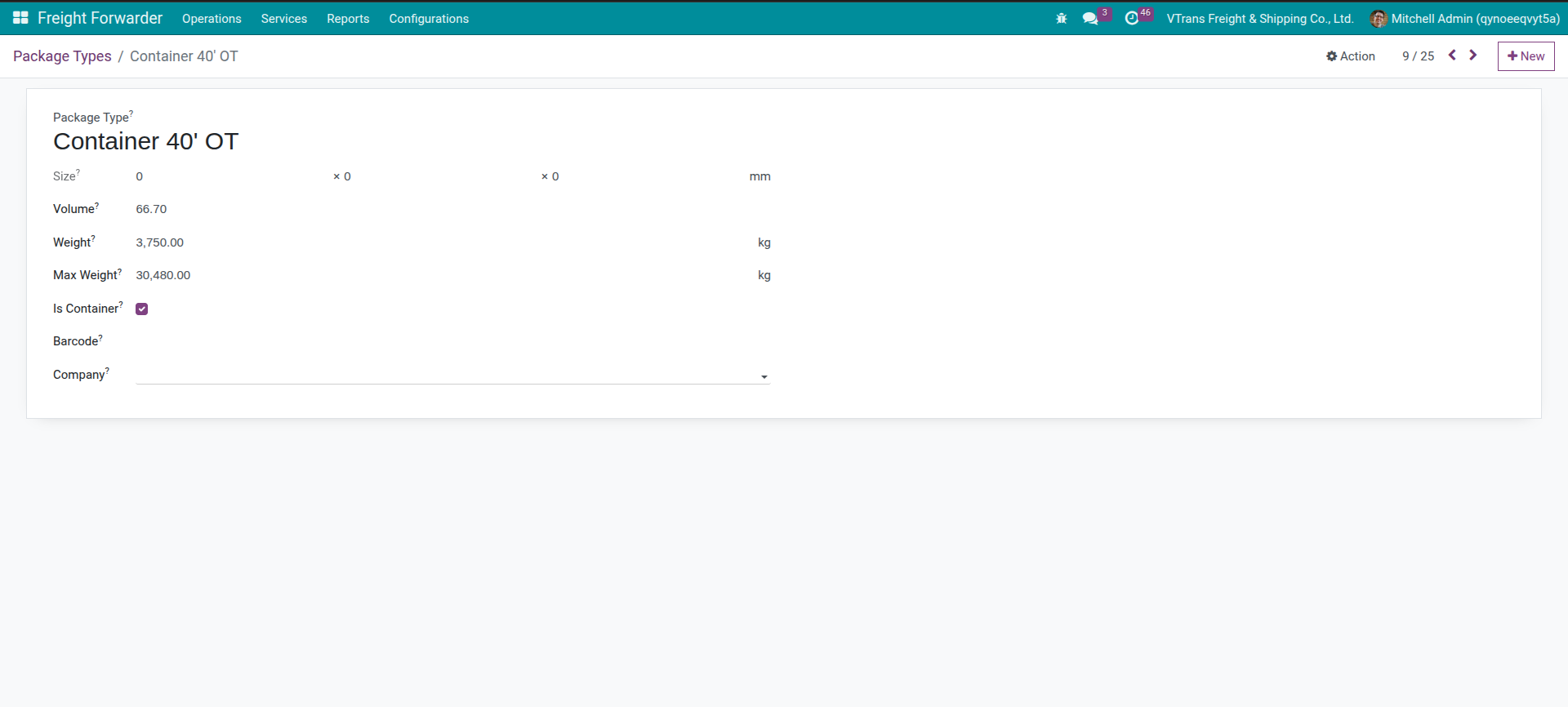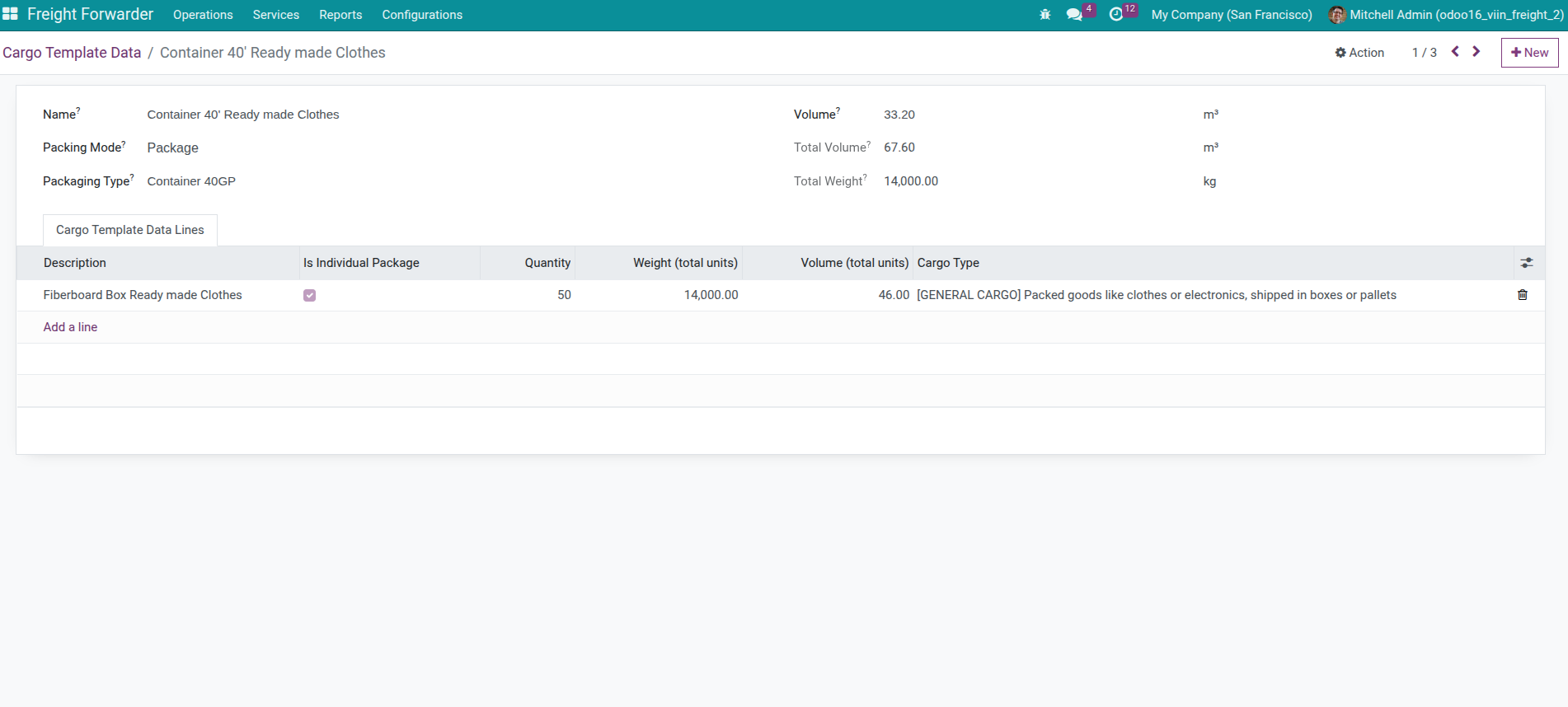Cargo Information Setup¶
Cargo Template Data¶
Purpose: Store frequently transported cargo information for quick entry.
When to use?
If your company frequently transports same type of cargo for same customer, creating templates will help:
Save 70% data entry time
Ensure consistent information (no wrong HS code, DG class…)
New employees also enter correctly
Real example:
- Customer A exports ceramic tiles to USA every month. Each time is:
2 containers 40ft
Each container: 28 pallets
Each pallet: 1,200 kg
HS Code: 6907.21
Not dangerous goods
- → Create template
Ceramic Tiles Export - Customer Aonce, then each new shipment only needs: Add cargo template to shipment
Click Generate Cargo From Templates
Done! System auto-creates 2 containers with complete information
How to Create Cargo Template¶
There are 2 ways to create cargo template in system:
Basic Information¶
- Template Name (Name):
Memorable name, should specify customer
Example:
Ceramic Tiles - Customer A,Electronic Parts - Samsung
Packing Mode:
Package: For packaged cargo (container, pallet, box…)
Bulk Cargo: For unpackaged cargo (sand, gravel, coal…)
Select Package if you transport in containers, pallets, carton boxes…
Tip
Packing mode is more than a label. When you choose Package, the template inherits the volume and name of the selected Package Type (based on the automation in freight.cargo.template.data), and the system expects you to detail every item inside the package so total weight is computed automatically. Switch to Bulk Cargo for oversize or loose goods; the template name becomes Bulk Cargo and you can enter total weight/volume directly without creating package lines.
- Package Type:
Packaging type used
Example:
40ft Container,20ft Container,Pallet
Note
If you don’t have needed Package Type, go to Inventory > Configuration > Package Types to create new.

Cargo Information¶
- Cargo Type:
Cargo classification
Example:
General Cargo,Refrigerated,Dangerous GoodsGo to Freight Forwarder > Configurations > Cargo Information > Cargo Types to maintain the master data. Each Cargo Type must have a unique code (the model automatically uppercases it) and you can add handling instructions in the description so they appear wherever the type is referenced. Investing a few minutes to prepare this catalog keeps templates consistent and helps the operations team filter shipments by cargo characteristics later on.

- HS Code:
Goods code according to Harmonized System
Used to:
Customs declaration
Calculate import tax
Check prohibited/restricted goods
Manage HS codes centrally via Freight Forwarder > Configurations > Cargo Information > HS Codes. Similar to Cargo Types, codes are forced to be unique and uppercased, so you can safely reuse them across cargo templates, quotations, and customs jobs. Pre-fill the description with local regulation notes (e.g., import license requirement, VAT rate) and link the HS code to cargo templates to estimate import taxes automatically.

- Country of Origin:
Country where goods are produced
Important for:
Determining tax (may get FTA preferential)
C/O (Certificate of Origin) requirement
- Import Tax Rate:
Expected tax rate
Used to calculate costs for customer
Cargo Details Tab¶
If in 1 package has multiple cargo types, add each type here:
Cargo Name |
Quantity |
Weight |
Volume |
HS Code |
|---|---|---|---|---|
Ceramic Floor Tiles |
28 pallets |
33,600 kg |
45 m³ |
6907.21 |
Packing Materials |
400 kg |
2 m³ |
4819.20 |
Method 2: Create from Actual Shipment (Convert to Template)¶
This is the quickest and most accurate way when you already have actual shipment for regular customer.
- Advantages:
100% accurate data - copied from actual shipment
Quick - no need to re-enter from scratch
Template name automatically includes customer name
Suitable for customers frequently transporting same type of cargo
Steps to perform:
Open shipment with complete cargo information
Go to Packages tab or Cargo Commodities tab
Select packages/cargo items to make template
Click Action → Convert to Template
System automatically creates template and opens list of newly created templates

Real example:
- Shipment SHP0045 for customer Samsung Vietnam has:
1 container 40ft HC containing 500 cartons of electronic parts.
Weight: 15,000 kg.
HS Code: 8517.12.00.
Made in Vietnam.
- After Convert to Template:
System automatically creates template with name: Container 40’ Electronic Parts - Samsung Vietnam
All information (weight, HS Code, cargo type…) fully copied.
Next time have similar shipment for Samsung, just select this template.
Tip
When should you use this method?
Customer just completed first shipment.
Customer commits to transport similar cargo in future.
You want to ensure template information is 100% accurate.
Save time compared to manual creation.
Note
Template created from this method will have complete detailed information including:
- From Package:
Package Type, Volume.
All Cargo Commodities inside package.
- From Cargo Commodity:
Cargo Type, HS Code, Country of Origin.
Weight, Volume, Quantity.
Dangerous Goods info (if any).
Handling Instructions.
When to Use Cargo Template?¶
- SHOULD use when:
Transporting repeat cargo for same customer.
Cargo has complex information (many types, many parameters).
Want to ensure consistency in data.
Need to train new employees.
- DON’T need when:
Each shipment completely different.
Simple cargo, little information.
Only use cargo note (free description).
